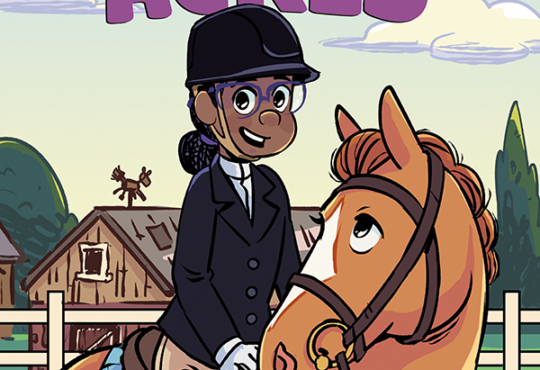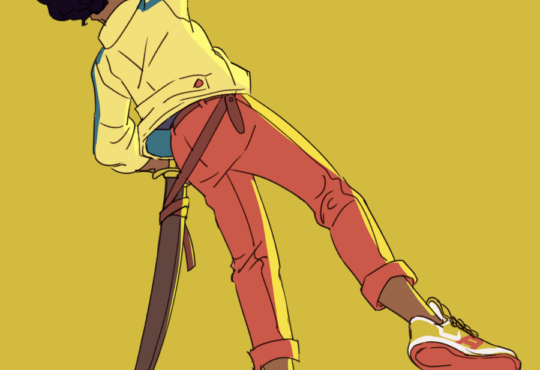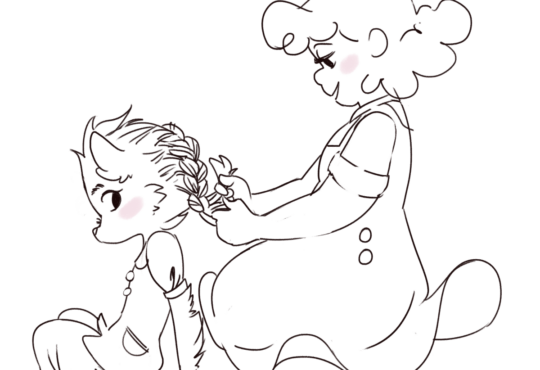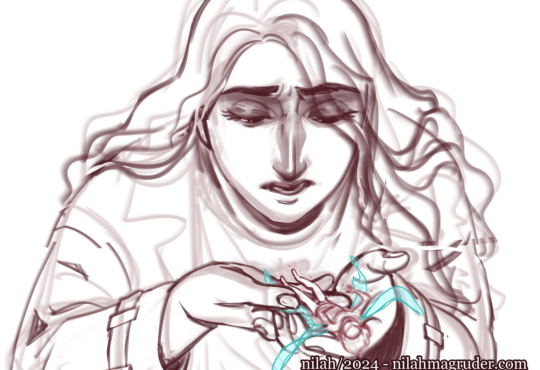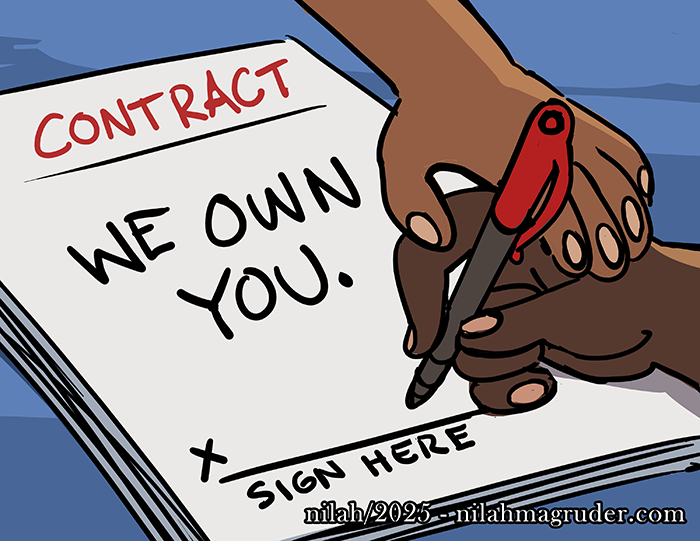
Don’t Take That Art Gig
This one goes out to the artists trying to make it in the professional world.
Don’t take that gig.
Let me elaborate.
Artists, no matter where you are in your career, no matter how desperately you need a paycheck, you must understand what your labor is worth, and you must set a floor for how cheaply you’re willing to sell your labor.
This means sitting down and doing the math. Figure out how much money you need to survive. Figure out how long it takes you to do the work you do. Come up with a base rate: the absolute lowest rate you can bear to take for your art.
And then, hold fast. Never accept work below that rate.
If a client can’t meet that rate, you tell them no. You say it kindly but firmly. Unfortunately I’ll have to pass on the project, but I appreciate you thinking of me. Best of luck!
You Are Not Cheap Labor
This is hard advice to give, especially when artists are just starting out, because we’re all tempted by the lure of a professional gig. When you’ve never been paid for your art, even one dollar seems like a step in the right direction.
It makes sense to start off with low expectations when you’re starting out. Take modestly paying jobs because you don’t have a lot of skill or experience, and as your skill and experience increase, you raise your rates.
This is a trap. When you accept a low rate, your clients aren’t thinking to themselves that they’re getting a really good deal. They’re thinking that you’re cheap labor, and you’re always going to be cheap labor. The next time they come back to you with a gig, they will expect to pay you what they paid you last time, regardless of how you’ve improved.
You may still be tempted to accept a low rate because you know the client. Perhaps they’re a relative, friend, or an industry professional that you respect. Your work still has value. Don’t give it away for free or for less than it’s worth.
I have found that whenever I betray my own principles and accept a low rate, the client is often more difficult to work with than my clients that pay more. I used to puzzle over this, and then it finally hit me:
People know slave labor when they see it. They know when they’ve got you over a barrel. Taking a low rate signals to clients that you’re desperate for work. You took their low rate because you can’t do any better. It gives them a sense of superiority. You’re cheap, so they don’t have to respect you.
Sometimes it’s not quite this malicious. A tight budget can also be an indicator of a stressful project. When there’s not enough money to get things done, everyone is on edge, and that stress is going to trickle down to you.
No job is worth your abuse and exploitation, especially when it barely pays!

So what’s tempting you? What are you hoping to get out of this low-paying gig?
Are you hoping for professional credits on your resume?
Credits don’t matter. In the arts, there is one question: are you good? The quality of your work is the thing that will ultimately make or break you. You don’t need to take low-paying jobs to get good. It’s not about who you work for, it’s about the time you spend developing your craft.
Besides, if the client doesn’t have the resources to pay you a respectable rate, how good could this project be? A cheap, low-quality project isn’t going to look good on your resume.
Did the client promise you exposure?
This is not your project. It’s the client’s project. The client is the one who’s going to get credit for it. They are going to do absolutely nothing to help you get the next gig, because all they care about is finishing this one. And when it’s done, they’ll be focused on lifting their own profile. Not yours. You are not their responsibility.
Do you think this will be a valuable learning experience?
A client paying you pennies or nothing at all for your labor has nothing of value to teach you. They have no idea what they’re doing. That’s why they think it’s acceptable to pay you so little. You are better off investing in a class.
Red Flags Through Rose-Colored Lenses
I find that we in the arts often approach projects with best-case scenarios in mind. We create a fantasy in our heads of the potential, all the opportunities for things to go our way.
Optimism is great, but you are a professional, and for the sake of your career, you must consider worst-case scenarios. You must imagine what a project may look like if everything goes wrong because more often than not, an artist’s dream job turns out to be a nightmare. And then you must ask yourself what is the lowest price that would make the nightmare worth it.
So, you’re new, you want to be a competitive candidate for the high-paying art gigs but you don’t have much of a portfolio, and I’ve just told you to turn down all the low-paying jobs that might give you the time of day.
What is a budding professional artist to do?
Make your own stuff!
When I was in your shoes, desperate for good work but all I could attract were the low-paying ones, I made a decision.
I would consider myself my best client.
I launched myself on projects I was excited about. I gave myself a reasonable work schedule. And when I spent money on my projects, I was investing in myself.
So now, whenever a client approached me with work, I asked myself:
Is what they’re paying worth more than the time I’m spending on my own projects?
If the answer was no, I declined the job.
I was already working for free, for myself. That knocked out unpaid work completely. I also had a full-time job. It didn’t pay much, but it did make my free time even more valuable, since it competed with my job. Now, for a freelance gig to be potentially interesting, the hourly rate needed to be worth giving up my free time.
Benefits to Focusing on Your Own Projects
Make Something You’re Passionate About
I believe strongly that when you love what you’re making, that love is visible in the work. Likewise, I believe when you don’t really care about what you’re making or even worse, hate what you’re making, then those feelings bring down the quality of the work. When you’re making art you’re invested in not for money but for sheer passion, you make stronger, more interesting art that catches eyes, wins awards, and leads to respectable job offers.
Work at Your Own Pace
It is hard to do good work under stressful deadlines. When you’ve got hard deadlines, the priority isn’t doing quality work, it’s finishing the work. It is common for a working artist to finish a job and afterward wish they’d had more time to develop the idea and polish it.
When you’re working for yourself, you can take your time to make the work the very best it can be.
Develop Your Skills in a Low-Stakes Environment
One of the many benefits to taking a job is to develop new professional skills that will level up your career. However, many studios are fast-paced, stressful environments. Everyone is rushing to meet deadlines and stay under budget. In this sort of environment, training of new employees is often neglected. It’s normal for new employees to be thrown into the deep end and pressure is high to get the work done with minimal supervision. This isn’t always out of malice. It’s usually because there’s simply no downtime in the schedule.
When your time is yours and no one knows what you’re working on (thus they can’t judge you), you can truly focus on experimenting and learning with every project. There is no pressure, no one looking over your shoulder, so you can afford to try new things, make mistakes, learn from them, and improve.
Show Studios What You’re Made Of
There is no better way to tell clients and studios what kind of creator you are than personal work. You want to tell studios why they should hire you specifically. If you’re working on another client’s project, you are executing their vision. Someone else is setting rules you have to adhere to. However, many productions are looking for a missing puzzle piece, someone who approaches art in a new and unique way. They want to see the way you communicate and solve creative problems. Making your own stuff is an excellent opportunity to show studios how you think, how you see the world, and the stories you want to tell.
It Belongs to YOU
In commercial art industries, you’re often working on someone else’s idea, someone else’s vision. They’re calling the shots and at the end of the day, they own whatever you make. When you’re working on your own projects, you’re the one in charge, and you own the end result. That also means you can do what you like with it. You control the medium and how it’s distributed. You control whether it gets made at all! We are in a time when studios are thirsting after intellectual property. They may offer big contracts for your idea, but that doesn’t mean they want to share the wealth fairly. Beware giving your ideas away too easily.
You Are Your Best Client
We think of full-time jobs as secure, stable places. You get benefits like health insurance and a steady paycheck. You don’t have to worry about work drying up unexpectedly, leaving you without income. However, these days in particular, no full-time job comes with guaranteed security. Many entertainment jobs are now temporary. Once the product is released and the production ends, workers are laid off. Productions are canceled unexpectedly at any stage of completion. Studios can just decide to cut jobs and there’s no promise that they will ever replace those jobs.
When you make your own stuff, you’re your boss. Your boss is as invested in your career as you are. You’re not going to fire yourself. You aren’t going to lock years of your work away behind NDAs you can’t break. You are your boss’s priority, something that will never be true when you work for someone else! And even when paying work gets lean, you will still have a creative outlet in your projects.
The Pen Is in Your Hands
I could also add that we artists work in a field that prizes entrepreneurial spirit. Art industries often reward creatives that make opportunities for themselves, whether that means producing a short film, launching an indie game, publishing a book, or starting a studio. It seems a little backward that the industry waits to hire people after they’ve gone ahead and made the thing they wanted to be hired to work on, but that’s how it is. To get work, you must already be doing the work.
But more than that, this is a lesson in not waiting for someone else to give you permission to do what you love. This is your life. No one can give you permission to live it. There is freedom in making the art you want to see in the world on your terms, completely unrestrained by gatekeepers and deadlines. Going this route may in fact be the key to doing work that you love.
So go, be free, and the next time you hear an artist thinking about taking a low-paying or no-paying job, tell them what I told you.
Don’t take that gig.
Make something, instead.

